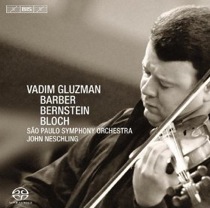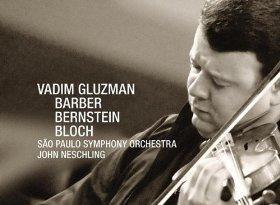Brimming with earnest and tender melodies by a 20th-century version of the Three B’s — Bernstein, Bloch, and Barber — this BIS recording showcases the abundant gifts of violinist Vadim Gluzman. Undeterred by the São Paulo Symphony Orchestra’s often lackluster contributions, the Israeli soloist offers proof of how rich and nuanced the often broad-brushed adjective “lyrical” can actually be.

Gluzman’s instrument sings, but in strikingly varied and eloquent ways. From the discursive dialogues of Leonard Bernstein’s 1954 Serenade, a programmatic gloss on Plato’s Symposium, to the chattering final Presto of Samuel Barber’s Concerto for Violin and Orchestra, Op. 14 (1939), the performer commands attention. His tone makes the first impression — a rounded, deeply rooted sound that depends on fullness rather than volume, ferocity, or the humid overlay of vibrato. There’s a sense of overall solidity, a handsomely lacquered density that can at any moment brighten with swirls of colors.
But it’s finally the assured grammar of his phrase-making, the long-lined sentences and unforced vocabulary of fleet runs and jaunty double-stops that distinguishes Gluzman’s artistry. All three pieces share a heartfelt frankness, an urge to speak in a direct, unmediated way. Gluzman brings that across without making any one of them plainspoken or naive.
Bernstein’s Serenade blends a certain literary pretentiousness (its five movements are keyed to characters and episodes in the Plato text) with the composer’s own inveterate theatricality: Some of the thematic material in the first movement anticipates songs from West Side Story. But as the composition migrates from hushed solemnity to cool-jazz interpolations and capering escapades, Gluzman finds a clear and lucid path through it all. At times his violin seems to be delivering clearly enunciated and specifically cadenced speech instead of mere notes.
Listen to the Music
Bernstein, Serenade after Plato's
Symposium I. Phaedrus
Gluzman, who recently performed the Brahms Violin Concerto in D Major with the Marin Symphony Orchestra, does some of his keenest work in Ernest Bloch’s Baal Shem — Three Pictures of Chassidic Life (1923). This work in three movements, while overtly theological in nature, lacks the specific program of the Bernstein. Bloch’s first movement is both meditative and penetrating. In the impassioned second movement, which has plenty of orchestral churning, the soloist holds his own and then some without grandstanding. The final movement, “Simchas Torah,” is an exultant praise song in a Coplandesque vein. Gluzman and the orchestra, sounding more engaged here, give it a joyous lift.
Barber’s Concerto, whose curious backstory of a contentious commission is related in the notes, is an uneven piece of work — gushingly cinematic at times and darkly taut at others. Even here Gluzman makes the strongest possible case.
Some persuasive passages notwithstanding, the São Paulo Symphony, under John Neschling’s direction, remains too often reticent and characterless. But context counts. Called on to work in tandem with a soloist of Gluzman’s vividness, many ensembles might pale in comparison.

